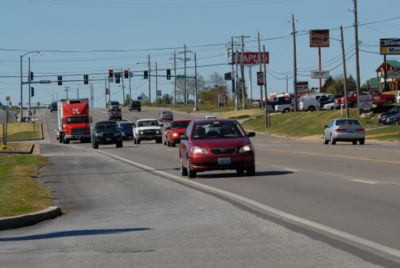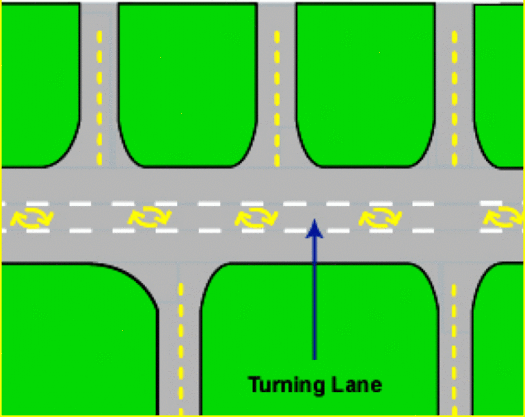940.10 Two-Way Left-Turn Lanes ("Five-Lane" Facilities)
| Additional Information |
| EPG 940.11 Three-Lane Cross-Sections |
A two-way left-turn lane (TWLTL) may be an effective access management tool when used with other techniques such as driveway consolidation and corner clearance. TWLTL cross-sections work best in situations where traffic volume and the density of driveways is relatively low, and the proportion of left-turning vehicles is relatively high. TWLTLs are recommended in places where commercial driveways make up a substantial portion of total driveways and where the percentage of vehicles turning left at peak hour is approximately 20 percent or greater.

TWLTLs may be inappropriate where the commercial driveway density is above the driveway spacing guideline. Research indicates that when commercial driveway density is over 24 per mile (12 per mile in each direction), crash rates increase significantly. This roughly equates to an average driveway spacing of 440 ft. Generally avoid TWLTL configurations unless driveway density can be kept at this level or below or other viable alternatives do not exist.
TWLTL configurations are not recommended along high traffic volume (over 28,000 AADT) urban routes. In such situations raised medians are at least 25 percent safer than multilane undivided sections and 15 percent safer than TWLTL cross-sections. TWLTL configurations are not to be used on facilities with more than four through-traffic lanes, e.g., to create a “seven lane” facility. Crash experience with such large roadway cross-sections is poor.

| Roadway Classification | In Current and Projected Urban Areas | In Rural Areas |
|---|---|---|
| Major, Freeway | Not applicable | Not applicable |
| Major, Non-Freeway | May be used when appropriate if AADT in design year is less than 28,000; otherwise use a raised median | Not recommended |
| Minor | May be used when appropriate if AADT in design year is less than 28,000; otherwise use a raised median | Not recommended |